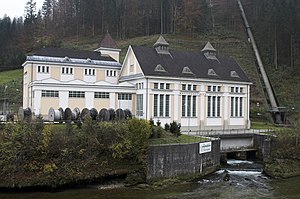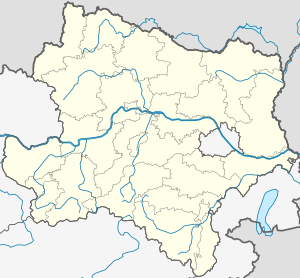Opponitz power plant
| Opponitz power plant | ||
|---|---|---|
| Power house near Opponitz | ||
| location | ||
|
|
||
| Coordinates | 47 ° 53 '25 " N , 14 ° 49' 46" E | |
| country |
Austria Lower Austria |
|
| place | Opponitz | |
| Waters | Ybbs | |
| Height upstream | 395 m | |
| power plant | ||
| Start of planning | 1921 | |
| construction time | 1922-1924 | |
| Start of operation | 1924 | |
| technology | ||
| Average height of fall |
115 m | |
| Standard work capacity | 66.8 million kWh / year | |
| Turbines | 3 Francis turbines | |
| Others | ||
The Opponitz-Mirenau power plant is a hydroelectric power plant owned by the City of Vienna in Opponitz an der Ybbs in Lower Austria .
Reason for establishment
In the first few years after the First World War and the subsequent collapse of the Danube monarchy, a large part of the Austrian budget was spent on importing energy - especially coal. In order to reduce these expenses, the expansion of Austrian hydropower has started.
In 1921, Wasserkraftwerke AG (WAG) was founded in Vienna with the task of supplying the city with hydroelectric energy. The owners of this company were initially the City of Vienna with 50 percent and various major banks ( Niederösterreichische Escompte-Gesellschaft , Creditanstalt , Allgemeine Depositenbank , Central European Länderbank , Allgemeine Österreichische Bodencreditanstalt , Allgemeine Verkehrsbank , Wiener Bankverein , Merkurbank) with a further 50 percent .
On December 18, 1922, the city of Vienna alone financed a capital increase of 200 million crowns, which increased the city's share in WAG to 75 percent. On December 7, 1924, the city became the sole owner of WAG through the purchase of shares owned by the banks
The plan was for WAG to initially build those power plants for which the City of Vienna already had the consensus, namely the Gaming water pipeline power plant on Vienna's Second Spring Water Pipeline and the Opponitz power plant. At the same time, the Gresten substation and a 110 kilovolt overhead line to Vienna from there were built. The expansion of the facilities was mainly necessary to supply the Vienna Electric Light Rail, which began operating in 1925.
Opponitz power plant
With the construction of this power plant, the gradient of the Ybbs on the 34 km long S-shaped winding section of the river between Göstling an der Ybbs and Opponitz will be used.
For this purpose, a weir with two openings of 16 meters each and a bottom outlet of four meters wide with a subsequent desanding system was built at Göstling an der Ybbs, initially after a short open channel
- the Sattelberg tunnel,
- the Buberstollen and
- Follow the Guttenfurthstollen (collectively: Königsbergstollen).
To build the Königsberg tunnel, two window tunnels were driven so that work could take place at six points of attack. During this construction work, the so-called Camillastollen of the Ybbstaler hard coal works was crossed.
At Sankt Georgen am Reith , where the Ybbs is crossed by means of a culvert and a pipe bridge with a span of 40 meters and the route of the Ybbstalbahn and the road are crossed, the gain in height compared to the course of the river is already 25 meters. The planners gave up the original plan to cross under the river itself by means of the culvert due to time and cost reasons after a flood that had destroyed the construction progress made so far and built the pipe bridge with around 40 meters as the only visible part of the valley crossing Span - a reinforced concrete bridge based on the Melan system.
Then follow it
- the Friesling tunnel (4,024 meters long),
- a covered slope canal stretch (532 meters in length) and to
- an aqueduct with a length of 24 meters to cross the Leithengraben
- the Hinterleithen tunnel,
- the Mitterriglstollen,
- the Kiesegg tunnel and
- the Koglstollen (together: Opponitzer Stollen).
These three tunnels with a total length of 2,277 meters, for the construction of which eight points of attack were created, are followed by the water tower and the 238 meter long pressure pipes with a clearance of 2.2 to 1.8 meters leading to the power house in Opponitz. A usable gradient of around 115 meters is achieved on this route, which is around 11.3 kilometers long.
The groundbreaking ceremony took place on January 17, 1922. On December 10, 1924, the first machine set was put into operation while idling, and electricity production began on December 27. In addition to the technical problems that the building caused, the increasing devaluation of money also caused difficulties, because the WAG found it increasingly difficult to get the funds it needed. The further construction was only possible with the help of the community, which advanced the construction. The money needed for this was obtained through a hydropower levy that was valid in September 1922 and until 1932 (4 percent of the price of a kilowatt hour of electricity and 2.5 percent of the price of a cubic meter of luminous gas ).
On the occasion of the national holiday of the First Republic and the commissioning of the power station in Opponitz, the Vienna City Hall was lit for the first time on November 12, 1924 . According to the commemorative publication, the Vienna City Hall was festively illuminated on the occasion of the commissioning on January 1 and 11, 1925.
The listed power house in the Schwarzenbach district was built by the construction company Innerebner and Mayer (formerly J. Riehl) . The machine room is housed in a steeply proportioned block with a gable roof and two ridge lanterns. The facade is windowed with three-part, generous window strips. The laterally offset low-voltage room has a flat roof.
Three Francis turbines were installed , which were originally ordered from Voith in 1912 for the Canadian power station Stadacona, but could no longer be delivered because the First World War broke out later.
Between July 31, 1994 and March 17, 1995, the power plant was renovated and modernized. This enabled the productivity of the plant to be increased from the original 56,400 MWh to 66,800 MWh.
Former high voltage line Gresten - Vienna
The electrical current generated in the Opponitz power station and stepped up from 5.5 kV to 110 kV was first conducted via a three-phase line via Ybbsitz to Gresten to the specially built transformer station. This is also where the lines coming from the Gaming water power plant and Upper Austria met .
From here, an approximately 140-kilometer-long line was built via Kilb , Michelhausen , Judenau, Königstetten and Sankt Andrä in the direction of Vienna. In the area of Tuttendörfl below the roller ferry from Klosterneuburg , the line crossed the Danube and continued to the Vienna-North substation on Jedleseer Straße in Floridsdorf . This was erected on March 11, 1924, and on December 14, the switchgear and transformer system was put under operating voltage.
The main part of this line was built by the Austrian Brown-Boveri works , while a smaller section was built by the AEG Union Elektrizitätsgesellschaft . The masts were made by the Viennese companies
- Max Wahlberg,
- R. Ph. Waagner,
- L. & J. Biro ,
- A. Kurz-AG and
- IG Gridl and then brought to their respective place of installation by train and cart. A total of 753 masts were planned for the Gresten - Vienna route, and 640 will be named after completion. The Danube was spanned on November 20, 1924. For this purpose, shipping traffic was blocked.
This high-voltage line was important for Vienna not only because of the electricity from the city's own Opponitz and Gaming plants, it was also the reason for the Upper Austrian Wasserkraft- und Elektrizitäts-AG (OWEAG) to accept half of the storage power plant under construction from the City of Vienna Partenstein to offer generated electricity.
Pictures from the construction phase
credentials
- ↑ a b c The New Vienna ... Volume IV
- ↑ http://www.wien.gv.at/rk/historisch/1948/mai.html
- ↑ http://www.more-powerful-solutions.com/vs_de_referenz_small_hydro_opp.htm
- ↑ About the status of the construction work ...
literature
- About the status of the construction work at the hydropower plants of the municipality of Vienna. By Ing.Franz Kuhn, head of the design office of Wasserkraftwerke AG, in the publishing house of Wasserkraftwerke-Aktiengesellschaft, Vienna, 1924
- Ybbskraftwerk Opponitz - In memory of the completion of the Ybbskraftwerk Opponitz and the 110,000 volt long-distance line Opponitz - Gresten - Vienna of the Wasserkraftwerke-Aktien-Gesellschaft (Vienna, 1924)
- Das neue Wien, Städtewerk, published with the official cooperation of the Municipality of Vienna , Vienna, 1927
- Dehio: Lower Austria south of the Danube, part 2 - M - Z , Berger Verlag, Horn / Vienna, 2003, ISBN 3-85028-365-8
- Valentin E. Wille: The founding power plants of the state producers. Architecture of former large power plants. Published in: Stalla et al .: Architecture and Monument Preservation. Studienverlag, Innsbruck-Wien-Bozen 2012, ISBN 3-70655-129-2 .











